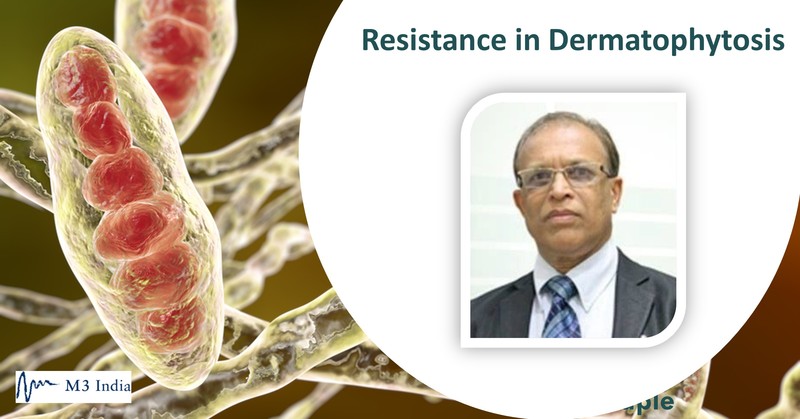Exclusive series: Resistance in Dermatophytosis- Dr. DG Saple
M3 India Newsdesk Mar 18, 2020
The growing incidence of antimicrobial resistance is well known, but increasing antifungal resistance- not as much. In this exclusive series, Dr. DG Saple explains that in order to understand resistance in dermatophytosis, it is important to first understand the factors responsible for it.

The growing prevalence of fungal infections all over the world has lead to dermatophytosis infections now being labeled a global public health problem. The epidemiology of this disease and the clinical outcome depends upon the host, environment, drug factors as well as the pathogenicity of the organism.
The current argument whether Trichophyton mentagrophytes or Trichophyton rubrum is the most common organism responsible for the chronicity of Dermatophytosis is further complicated by the fact that multiple small demographic studies are being conducted within a small span of time. The current need to get a clear picture is to conduct a pan-India study so that we are able to obtain a better epidemiological profile for dermatophytes in the country.
In order to tackle such an epidemic, it is very important to understand these factors before we label any organism to be resistant to a particular drug. We need to differentiate whether we are really dealing with anti-fungal resistance or is it just infact a case of clinical failure or recurrence/re-infection.
The development of antimicrobial resistance to drugs is almost an inescapable phenomenon in today’s times owing to the rampant use of over the counter medications. However, the resistance to anti-fungal drugs is not as rampant as compared to the anti-bacterial medications. Owing to the high number of recalcitrant or recurring cases of superficial mycoses being encountered in our country, it is very important to understand the reasons for antifungal resistance. The factors responsible for antifungal resistance are below.
Fungal factors
- Alteration of the target gene [1]
- Increase of drug efflux [1]
- Metabolism modification [1]
1. Target Site alteration: Altered target (14α-demethylase)- point mutations in ERG11 gene (Y132H,D278E) leading to resistant but functional ERG11 genes. ERG11 gene is important for intrinsic resistance to fluconazole seen in C.krusei (reduced enzyme susceptibility). [1]
2. Efflux Pumps: ATP-binding cassette transporters (ABCT)- azole drug resistance is associated with the CDR (Candida Drug Resistance) gene family. In T. rubrum, two ABC transporters, like TruMDR1 and TruMDR2 were identified as playing important roles in the development of resistance. Major Facilitators (MF) - MDR1 gene is found to be azole specific. [1]
3. Metabolism Modification:
- Echinocandins paradoxical effect: Some yeasts and filamentous fungi are able to grow in elevated echinocandin concentrations much higher than the MICs.
- De Novo synthesis of pyrimidines: It is possible that 5FC resistance could be the consequence of an overall induction of the de novo pyrimidine biosynthetic pathway.
- Ergosterol biosynthesis pathway alteration: Modifications of main metabolic pathways could also lead to azole drugs resistance. [1]
However all these factors are mainly associated with resistance in Candida infections, and only few reports have come for dermatophyte resistance, mainly terbinafine. A method to measure antifungal susceptibility is now established. Micro-Both dilution method is the most commonly used method for in-vitro antifungal susceptibility testing and to study whether dermatophytic resistance actually exists.
Based on these studies, resistance is not a problem (most compelling data is from terbinafine). There is a lack of data concerning the susceptibility profile of agents. [1] For dermatophytes, unlike for yeasts, the in vitro-in vivo correlation is lacking and no interpretive breakpoints have been established for any of the drugs used to treat dermatophytosis.
Till date, the only cases of therapeutic failure documented was reported from Switzerland, wherein 2 cases of resistance of Trichophyton rubrum to terbinafine was documented in cases of Onychomycosis. Both cases were due to single point mutations in the gene coding for squalene epoxidase, with missense substitutions (Leu393Phe in one & Phe397Leu in the other), resulting in 100 fold rise in MIC. However, the higher MIC’s seen in in-vitro studies in the western literature may not be the sole cause of therapeutic failure in the Indian population.[2]
In the current scenario, therapeutic failure or clinical failure most commonly observed, is due to complex interaction of host factors, Drug factors and virulence of the infecting fungal species, and poor adherence to the prescribed regimen and failure to take the treatment for atleast 6 to 8weeks, continues to be a deterrent in achieving complete cure of the infection. [3] Thus, most of the cases encountered in the Indian clinical practice are clinical failure, rather than resistance.
This article is part of an exclusive series on Dermatophytosis by Dr. DG Saple.
Click on the following links to read them-
Emerging recalcitrant dermatophytosis in India
Exclusive series: Diagnosis of Dermatophytosis- Dr. DG Saple
Click here to see references
Disclaimer- The views and opinions expressed in this article are those of the author's and do not necessarily reflect the official policy or position of M3 India.
The author, Dr. DG Saple is a Senior Consultant and Director of Dermatology at a Mumbai-based clinic.
-
Exclusive Write-ups & Webinars by KOLs
-
Daily Quiz by specialty
-
Paid Market Research Surveys
-
Case discussions, News & Journals' summaries